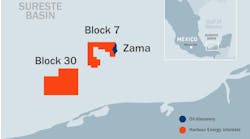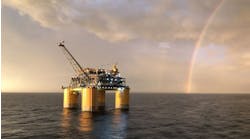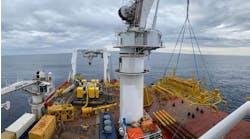Kevin McMillin
Houston
A record 54.1 in. penetration depth (Schlumberger).
Downhole high-temp electronics an industry priority
High temperature electronics is becoming a priority in the oil and gas industry. The recent High Temperature Electronics Seminar in Houston, sponsored by the Gas Research Institute and Spears & Associates, drew participation from service companies and operators alike.Deeper wells mean higher temperatures. The industry is already experiencing the problems associated with high temperatures, and are developing solutions to deal with them. However, a common limiting factor that all companies are encountering is incapable electronic components. Current electronic components operate normally to approximately 350° F, where erratic performance or in most cases, catastrophic failures start to occur. The problem is not specific to any one vendor.
Service providers utilize similar electronics in their downhole tools; the difference is in packaging and configuration of the electronics. Another unfortunate electronics industry trend is that vendors supplying service companies with electrical components are slowly decreasing the qualification specifications of their products. This comes as a result of the electronics industry adopting lower, more cost effective standards set forth in the Customer Off The Shelf (COTS) policy the government has already implemented. Stringent military specifications are no longer the minimum for consumer electronics. As a result, the oil and gas industry, being a relatively small consumer in the global electronic component market, is experiencing difficulty purchasing capable components for downhole tools and equipment. Also, being a relatively small consumer in a global market makes it difficult to convince electronics manufacturers to build components to oil and gas industry specifications and at reasonable cost.
Oil and gas industry service providers currently deal with the situation by dealing with vendors directly, developing components for their specific needs and accounting for the cost in their respective operating budgets. Although this process gives service providers a feeling of security in maintaining their competitive stance with competitors, may not be the most cost effective alternative.
GRI and Spears and Associates have proposed a consortium to help the industry address this issue by using a program similar to the High Temperature Distributed Control Systems Consortium (HiTec) in the aerospace industry. Benefits of the proposed consortium would be improved reliability of specific components to 200° C, member reduced R&D cost, components will be service company selected, availability to technical information for 2 years, and service company competitive stance maintained in the oil and gas industry.
A joint-effort approach to the electronics manufacturing companies can more effectively relate the oil and gas industry's specific electronic component needs, and allow for quicker development of products and services.
Level 6S multilaterals become more economic
It is estimated that as of December 1998, less than 10 downhole-installed Level 6S multilaterals have been performed. This is most likely a result of the requirement for drilling a larger surface hole for tools to be drifted through. Operators are opting for cheaper alternatives utilizing surface-installed splitting techniques. However, recent innovative designs and the realization of longer term benefits of downhole-installed systems is creating interest in downhole-installed systems. Baker Oil Tools is marketing two different alternatives for this market.- One alternative allows for completion and production of two individual wells utilizing standard conductor pipe and the Downhole Splitter™.
- The second alternative allows for single or dual completion with commingled or separate production. The system utilizes the Deepset Splitter™ and allows for re-entry into each lateral, requires no debris-causing milling, and allows for a single tieback to surface equipment.
Schlumberger deepens perforating record
Schlumberger Wireline & Testing recently announced the achievement of a new record for perforation penetration depth into an API RP43 test target. An HSD gun utilized the new PowerJet shaped charge system to penetrate 54.1 in. into the test target, exceeding the previous record by 4.1 in. Tom Zimmerman of the Schlumberger Perforating and Testing Center stated: "By penetrating deeper into hard formations at higher shot densities, shooting further past formation damage and intersecting more natural fractures, the PowerJet charges allow our clients to significantly increase oil and gas production."Sale re-shaping MWD/LWD business
Halliburton recently announced an agreement to sell the company's Pathfinder Measurement and Logging While Drilling (MWD/LWD) business to Houston-based W-H Energy Services. The sale should conclude Halliburton's antitrust review obligations with the US Department of Justice. Sale formalities should be finalized by the end of March. The sale creates a unique and unprecedented shift in the MWD/LWD service business.The large service providers and various smaller providers have provided basic MWD services such as directional surveys, steering information, and in some instances, a gamma ray measurement, for the past two decades. The high tech LWD measurements were developed and almost exclusively marketed by the larger service providers. The larger R&D and operating budgets, and the availability of more technical expertise these companies had at their disposal, allowed them to dominate this particular market. This sale could give the industry an unprecedented lower cost LWD service provider.
Historically, LWD services have been a big portion of an operating company's downhole drilling tool budget. Having to recover R&D costs of these tools forced service providers to ask relatively high day rates for their use. By buying a developed and proven system, W-H will have an opportunity to market a LWD service at lower cost. For operators, this is good news. A lower cost alternative, and keeping a fourth provider in this market is good for competition. And we all know that competition encourages technological advancement and better quality products.
Copyright 1999 Oil & Gas Journal. All Rights Reserved.


